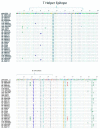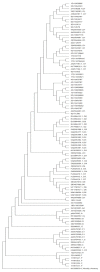Nucleotide Substitutions in Hepatitis B Viruses Derived from Chronic HBV Patients
- PMID: 31308922
- PMCID: PMC6613622
- DOI: 10.4084/MJHID.2019.046
Nucleotide Substitutions in Hepatitis B Viruses Derived from Chronic HBV Patients
Abstract
Background: Mutations in the S gene (HBsAg), pre-core (PC), and basic core promoter (BCP) of the hepatitis B virus (HBV) infection are correlated with disease progression. This study assessed the frequency of mutations in the S gene, PC, and BCP regions in chronic hepatitis B (CHB) patients.
Methods: 104 formerly known CHB patients who visited Tehran Hepatitis centers, were included. The viral load of samples was determined based on the TaqMan method. Regions of the S gene, PC and BCP were amplified by the nested PCR. Positive PCR products were sequenced and analyzed.
Results: 33 successfully sequenced S gene region revealed all the derived strains were genotype D, with the majority (90.9%) belonging to the ayw2 subtype, and the rest (9.1%) to the ayw1 subtype. The prevalence of mutations was found to be 51.0% and 18.0% in the HBsAg and the Major Hydrophilic Region, respectively. 70.0% of amino acid changes within HBsAg occurred in different immune epitopes, of which 27.0% and 72.0% were located in B cell and Th epitopes, respectively. 26 successfully sequenced PC and BCP regions showed at least one mutation in 84.6% of the HBV strains. The PC and BCP mutations were G1896A (61.0%), G1899A (23.0%), A1762T/G1764A (23.0%) and G1764T/C1766G (26.0%). None of the strains with A1762T/G1764A mutation carried the G1764T/C1766G mutant.
Conclusions: Our results showed common mutations within HBsAg, occurring in immune epitopes, a high rate of G1896A mutations in the PC region, and a negative correlation between the emergence of A1762T/G1764A mutation and the G1764T/C1766G mutant in the BCP region.
Keywords: Chronic hepatitis B; Hepatitis B e antigen; Hepatitis B surface antigen; Hepatitis B virus; Mutation.
Conflict of interest statement
Competing interests: The authors have declared that no competing interests exist.
Figures



Similar articles
-
[Analysis of the relationship between hepatitis B virus precore and basal core promoter mutations and acute-on-chronic liver failure].Zhonghua Gan Zang Bing Za Zhi. 2012 Sep;20(9):644-8. doi: 10.3760/cma.j.issn.1007-3418.2012.09.002. Zhonghua Gan Zang Bing Za Zhi. 2012. PMID: 23207226 Chinese.
-
Hepatitis B virus basal core promoter/precore mutants and association with liver cirrhosis in children with chronic hepatitis B virus infection.Clin Microbiol Infect. 2016 Apr;22(4):379.e1-379.e8. doi: 10.1016/j.cmi.2015.10.033. Epub 2015 Nov 11. Clin Microbiol Infect. 2016. PMID: 26577140
-
Different precore/core mutations of hepatitis B interact with, limit, or favor liver fibrosis severity.J Gastroenterol Hepatol. 2016 Oct;31(10):1750-1756. doi: 10.1111/jgh.13338. J Gastroenterol Hepatol. 2016. PMID: 26992056
-
Detection of Immune Escape and Basal Core Promoter/Precore Gene Mutations in Hepatitis B Virus Isolated from Asymptomatic Hospital Attendees in Two Southwestern States in Nigeria.Viruses. 2023 Oct 31;15(11):2188. doi: 10.3390/v15112188. Viruses. 2023. PMID: 38005866 Free PMC article.
-
Features and clinical implications of hepatitis B virus genotypes and mutations in basal core promoter/precore region in 507 Chinese patients with acute and chronic hepatitis B.J Clin Virol. 2010 Mar;47(3):243-7. doi: 10.1016/j.jcv.2009.12.013. Epub 2010 Jan 15. J Clin Virol. 2010. PMID: 20080060

